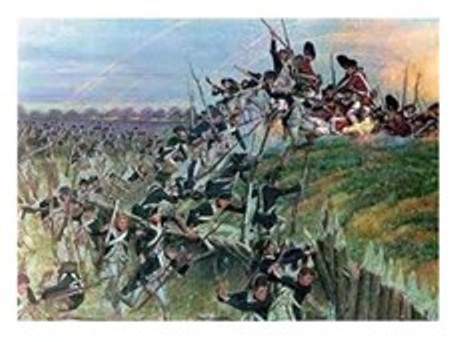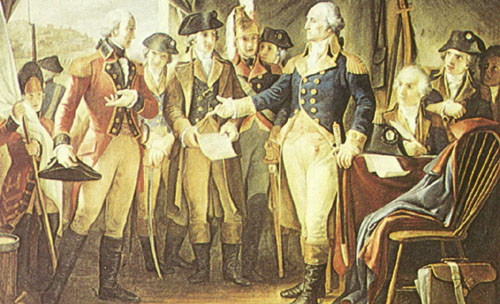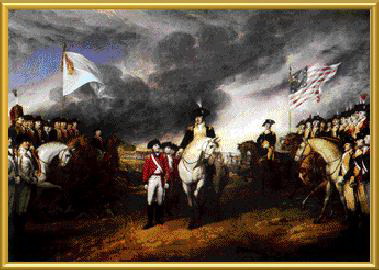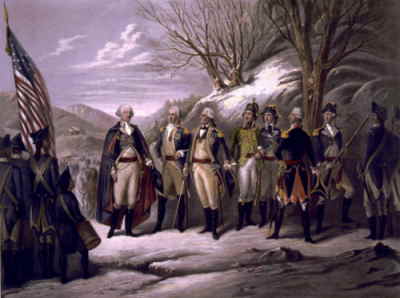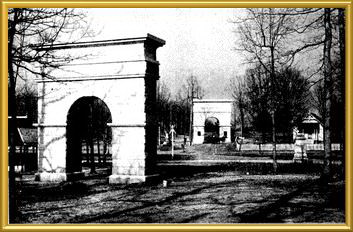 Armchair Genealogy
Armchair Genealogy
By
Melinda Cohenour
The Story of David Motley Ellington,
An American Patriot
Part II
This column resumes the fascinating story of David Motley Ellington’s service in the Revolutionary War. Most of the information has been derived from the Pension Application he first filed in 1834. As previously reported in the author’s column for May 2016, the first Act authorizing remuneration for those who served in the Revolutionary War without proper recompense was enacted 7th June 1832 by the Congress of the United States.
Ellington’s initial application was filed on his behalf after he had suffered a probable stroke that left him “afflicted with a long spell of sickness, which has almost deprived him of recollection.” As a result, in his old age and suffering from the resultant memory loss, he struggled to recall the names associated with his service. The author has attempted through extensive research to track his recalled events of service with factual accounts of the War. In 1844, David Motley Ellington was spurred by his children to renew his application, believing him to have been wrongly deprived of his just rewards. Some of the research, thus recounted in this series of two columns, has been derived from a review of the full Pension Application package on file with the United States government and transcribed previously by the author, painstakingly attempting to translate the archaic handwriting and, in some cases, weathered and damaged original documents.
In many instances, names provided by Ellington in his application package have been shown to be recorded along with service that emanates from Amelia County, Virginia. For instance, on the 2nd day of January in 1844, Ellington’s application mentions the name of Lt. Joshua Hundley:
He States that his recollection does not serve him accurately respecting his officers, as well as he can remember he served under Capt. Phillip Payne and Capt. (blank) Harrison; Lieutenant Joshua Hundley served in the same company with him throughout a greater part of the time in which he was engaged in the Service.
Research shows that one Lt. Joshua Hundley did, indeed, serve. The Virginia State Library, in its List of the Revolutionary Soldiers of Virginia (Supplement), a Special Report of the Department of Archives and History for 1912, compiled by M. J. Eckemp, QDE, the Archivist, reflects the following:
Lt. Joshua Hundley: Hundley, Joshua (11 V. R.), W. D. 224, 1; (15 V. R.), W. D. 272, 1; (5 & 11 V. R.), W. D. 327, 1; (11 & 15 V. R.), W. D. 343, 1.
This means one, Lt. Joshua Hundley, served with the 11th Virginia Regiment, as reported by the War Department, at page 224,1. That his service continued with the 15th Virginia Regiment, as reported by the War Department at 272, 1; that his service continued in the combined 5th and 11th Virginia Regiments as reported by the War Department at page 327, 1; and carried forward as the combined 11th and 15th Virginia Regiments, as reported by the War Department at page 343, 1.
Per Wikipedia:
The 11th Virginia Regiment was a Continental Army regiment that fought in the American Revolutionary War.
Authorized by the Second Continental Congress on 16 September 1776, it was organized on 3 February 1777 and consisted of four companies from the Virginia counties of Loudoun, Frederick, Prince William, and Amelia; Captain Daniel Morgan's Independent Rifle Company from Fauquier County; and five companies from the state's portion of the Maryland and Virginia Rifle Regiment.
In researching the name “Harrison” as one of Ellington’s superior officers, we find one Benjamin Harrison who was mentioned in a Harrison family genealogy report as “the other Benjamin Harrison” as having been one of Morgan’s “Indian fighters” who was called upon to join his unit and given some level of supervision.
This would appear to substantiate at least part of the accuracy of David Motley Ellington’s recollection. His pension application(s) were further supported by various affidavits of those who knew him for many years, knew him to be a truthful man, and had recollection of both he and his cousin, David Motley’s service during the Revolutionary War. Given that other researchers have felt their efforts rewarded by an assurance of the validity of his claims, I continue to share the facts of his remarkable service through his own voice:
States … from thence we was marched to Gilford (Guildford) Courthouse in the State of North Carolina where we again had a Battle with the Brittish and Tories in which battle we was compelled to retreat from thence we was marched to Richmond in the State of Virginia and thence
"The Battle of Guilford Court House" March 15, 1781.
After Morgan's victory in the Battle of Cowpens, both Morgan and Greene knew that Cornwallis would not allow the victory to go unavenged. At the same time, Morgan did not want to give up his prisoners or supplies. Greene thus directed his army north, while at the same time taking direct control over the troops of the badly ailing Morgan. Greene then masterly withdrew northward, skillfully delaying Cornwallis all the way. In order to catch up with the Americans, Cornwallis burned his supply train and extra supplies. Greene retreated all the way back to Virginia, pulling Cornwallis the whole way. When it became clear that Greene and the Americans had gotten away, Cornwallis realized how exposed he was, with no supplies in hostile territory. He began withdrawing southward. Greene and the Americans followed. When the British arrived at Guilford Court House, Greene felt the time was right to fight. Green had 4,300 troops, of which 1,600 were Continental regulars, facing 2,200 British regulars. The battle lasted for most of the day. The result was a British victory in the sense that the Americans were dislodged from their positions and forced to withdraw. The cost to the British, however, was too high. The British lost 93 killed and 439 wounded, while the Americans lost 78 killed and 183 wounded. Cornwallis' army was now in tatters. Source: American Revolution Website -Battle of Guilford Courthouse
Illustration: Location of the Battle of Guilford Courthouse, where Morgan and Greene engaged General Cornwallis' British troops resulting in a great loss of life and many injuries to Cornwallis' army.
States … to Yorke Town in said State and joined the main army commanded by General Washington at which place we remained until discharged as all hostilities Seased in the year 1781, with the Brittes;
"The Battle of Yorktown" October 6-19, 1781.
The Battle of Yorktown began after the Battle of Guilford Court House. At that time, British General Cornwallis moved his battered army to the North Carolina coast, then, disobeying orders from General Clinton to protect the British position in the Carolinas, he marched north to Virginia and took command from Loyalist (Tory) General Benedict Arnold. At the same time, General Washington was planning to attack New York with the help of the French, who had been convinced by Benjamin Franklin to join the Patriots. Because the British knew of the Patriots' plan to attack New York, they did not send reinforcements to General Cornwallis in Yorktown. General Cornwallis had been ordered to bring all his men to New York, but again he did not obey orders. Instead, Cornwallis kept all of his troops, totaling about 7,500, and began fortifying Yorktown and Gloucester, across the York River. Washington sent his French aide, the Marquis de Lafayette, to Virginia in the spring of 1781 with a few Continental troops. Lafayette observed Cornwallis’s troop movements up the Carolina coast and their settling in at Yorktown. Upon hearing this news, Washington abandoned his plans to attack New York and Washington and French General Rochambeau, with 2,500 Continental and 4,000 French troops, started their march to Philadelphia. General Clinton realized the Americans were not going to attack New York, and ordered the British fleet to the Chesapeake Bay. On August 30, Admiral de Grasse, with the French fleet arrived at the Chesapeake Bay and the British fleet from New York arrived on September 5. A naval battle ensued, with the French navy driving off the British fleet. 3,000 French troops from the naval fleet joined with General Washingtons army. After waiting a few days while the British admirals Graves and Hood sailed back to New York, the Americans attacked. Cornwallis was besieged by a Franco-American force of 16,000 troops. They captured two main redoubts on October 14. The British launched a counterattack but it failed. Cornwallis was outnumbered, outgunned, and was running out of food. Realizing that his situation was hopeless, Cornwallis asked for a truce on October 17. He surrendered to George Washington on October 19, 1781. Back in New York, the British admirals had been deciding on how and when to rescue Cornwallis. On October 17th a British fleet finally set sail out of New York, but it was too late. And when General Clinton, who had been marching towards Yorktown with 7,000 reinforcement troops, learned of the surrender, he turned back to New York. The surrender of Yorktown ended the fighting in the War for American Independence, except for some minor fighting that continued in the south, and other battles that still went on overseas. Losses on both sides were light: British and Hessian 156 killed and 326 wounded; French, 52 killed and 134 wounded; American, 20 killed and 56 wounded. The Battle of Yorktown, is recognized as one of the most skillful military actions in history. The British prime minister, Lord Frederick North, resigned after Cornwallis's surrender. The new leaders signed the Treaty of Paris on September 3, 1783, which officially ended the American Revolution. Source: American Revolution - Website American Revolution -Battle of Yorktown
Illustration: Battle of YORKTOWN - 1781
He states that he fought in the Battle of Guilford Court House when General Green commanded the army after Gen Gates had been defeated at Camden. He then continued as a regular soldier in the Infantry service with the Continental Service until Lord Cornwallis surrendered at Yorktown where he was & saw him deliver his sword.(This from an appeal of his original pension application, the appeal being filed in Crittenden County, Kentucky on the 2nd day of January 1844, some ten years following his initial application.)
Request for Truce and Surrender of Cornwallis
Illustration: Cornwallis was outnumbered, outgunned, and was running out of food. Realizing that his situation was hopeless, Cornwallis asked for a truce on October 17. He surrendered to George Washington on October 19, 1781
Illustration: Troops, horses, carriages, canon, artillery, and supplies surrendered by Cornwallis to Washington. The Articles of Capitulation detailed the flags to be furled and the songs to be played as the historic surrender occurred.
Illustration: David Motley Ellington participated in the Battles of Cowpens, Guilford Courthouse and Yorktown, Virginia, resulting in the resounding defeat of General Cornwallis and his ultimate surrender to General George Washington.
One of David Motley’s sisters married Capt. Joseph Motley, III, and named one of their sons David James Motley. This cousin to David Motley Ellington would play a large role in the life of our 5th great-grandfather. They fought together in the Revolutionary War until cousin David Motley was severely wounded in the leg at the Battle of Guilford Courthouse (noted in the book The Patriots of Cowpens, by Bruce G. Moss.)
From the website, flemingmultimedia.com/Genealogy/DavidJamesMotley.html, we find the following text:
David James Motley
born: 1753 in Amelia County, Virginia
died: abt 20 March 1826 in Pittsylvania County, Virginia
Military Service: Revolutionary War - Co B, 38th Regiment Military Service, Amelia County, Virginia.
(Virginia Magazine of History and Biography, Vol. 2, p 368) He was in Howard's Continental line behind Pickens' Militia and ahead of Washington's Cavalry along the Green River Road at the Battle of Cowpens. His uncle, David Ellington, Jr., stated that the two of them were together in campaigns and that David was wounded in the leg at Guilford Courthouse. (The Patriots at Cowpens, by Bobby G. Moss.)
It would appear all of David Motley Ellington’s family played some important role in the gaining of our Independence from Britain. Martha Ellington, David’s sister, married Capt. Joseph Motley, III, who served General George Washington as Captain during the French and Indian Wars and was with him at Braddock’s defeat and served the Continental Army as a Supply Agent. (Per Find-A-Grave memorial # 101049722, originally created by deefraver on 21 Nov 2012.) It is believed that her husband’s service in this connection led a group of Tories and their Indian conspirators to invade her home in the Captain’s absence, while she lay abed after the birth of their 11th child, and torture her in an attempt to gain knowledge as to his whereabouts and the location of the stores of armament and other goods.
His father, Jeremiah Ellington, is said to have maintained a store of food and goods to help the Patriots. Due to his advanced age, this was the extent to which he was able to serve, but he served, nonetheless. He is noted as “supplying beef to the Continental Army.”
In summary, it behooves me to relate for my children and theirs, our relationship to David Motley Ellington, the Patriot.
David Motley Ellington married Mary Malone DuPuy, 27 October 1785 in Amelia County, Virginia. During their 37 years of marriage before their annulment 22 October 1821 (basically, a divorce so named at that early time), they had eight children, among them their third-born, Prudence Ellington (1788-1860).
Prudence Ellington married John Wade 29 Oct 1806 in Greenup County, Kentucky. It is believed the Ellington family resided together here for some time before the divorce of David and Mary.
After the divorce (and some think, perhaps, the causative factor being a disagreement concerning the intended move) Mary Malone DuPuy Ellington moved with her children to Missouri. Prudence Ellington moved with her mother to Platte County, Missouri following the divorce and separation of assets.
While still living in Virginia, Prudence and John Wade had a son named Peyton Wade, born 25 May 1808.
Peyton Wade moved along with his mother, her siblings and his grandmother to Missouri. There, in Clay County, Missouri, Peyton married Elizabeth Wilhoit on 26 October 1832. In 1847, the exact date not being known, they had a daughter they named Martha Ann. By 1850, the US Census, would record their family in Fishing River, Clay County, Missouri. At that time, it would appear Martha was one of eight children of the marriage.
On 12 August of 1866, Martha Ann Wade would wed Absalom Creek, the son of Virginia Lee Younger and Jacob Haudenschildt Creek. Virginia Lee Younger was the sister of Henry Washington Younger, the father of the sons who would later become infamous as the Younger Gang.
Martha Ann Wade Creek and her husband, Absalom, would have seven children, the next to the youngest being Flutie Creek, born 19 August 1877 in Lockwood, Dade County, Missouri.
Flutie Creek would first marry Lewis Wallace Alexander (born 22 March 1862 in Crawford, Indiana and died 29 August 1941 in Los Angeles, California.) Their marriage ended in divorce only a few years after its inception, but not before the birth of their only child, a daughter, named Nora Viola Alexander. (Flutie would later marry Russell Kendrick, a Spanish American War veteran.)
Nora Alexander was born 23 December 1896 in Galena, Cherokee County, Kansas. She was the only child of Flutie Creek Alexander, but had a half brother from “Wall” Alexander’s first marriage to Ida M. Qualls, who it is believed died giving birth to Nora’s half-brother Thomas Wallace “Tommie” Alexander on 30 October 1894 in Willow Springs, Howell County, Missouri.
Nora Alexander married first Everett Marion Carroll (born 11 February 1894 in Joplin, Jasper County, Missouri). Their marriage vows were exchanged 22 December 1912 in Barton, Missouri. This marriage would result in the birth of one child, their son, John Edward Carroll.
John Edward Carroll was born 19 October 1913 in Joplin, Jasper County, Missouri. He would marry Lena May Joslin in Pineville, Missouri, on 10th June of 1934. Their marriage would result in the births of four daughters, Mary Elizabeth, Noralee Edith, Jacquelyn Earlene and Melinda Ellen Carroll.
Researched and compiled by author.
Click on author's byline for bio and list of other works published by Pencil Stubs Online.
|
